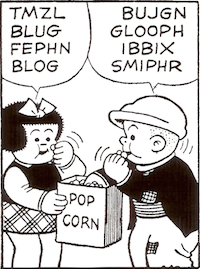[Imaginary liner notes for Van Dyke Parks’s new recordings.]
“Dreaming of Paris” (Parks) b/w “Wedding in Madagascar (Faranaina).” Produced by Van Dyke Parks and Matthew Cartsonis. Sleeve art by Ed Ruscha. Bananastan B4501. 2011.
“Wall Street” (Parks) b/w “Money Is King” (The Growling Tiger). Produced by Van Dyke Parks and Matthew Cartsonis. Sleeve art by Art Spiegelman. Bananastan B4500. 2011.
These releases — the first two of six 45s, with sleeve art by eminent American artists — are Van Dyke Parks’s first commercial solo recordings since the 1998 Warner album Moonlighting: Live at the Ash Grove (an excellent introduction, by the way, to The Man and His Music). Note: the first solo recordings. Since 1998, Parks has been heard on record countless times as an arranger, co-writer, and collaborating musician (with Inara George, Joanna Newsom, Ringo Starr, Rufus Wainwright, and Brian Wilson, among others). In 2010 Parks toured for the first time in Europe and North America; in 2011 he has played in Europe and Australia. He may be, as he puts it, “redundant” in the record business, but he does get around. And now he’s recording on his own terms, with vinyl available by subscription, in a project he describes as “Nouveau Niche.”
Fans of the 1995 Parks–Wilson collaboration Orange Crate Art might associate “Dreaming of Paris” with that album’s “Sail Away.” Here the escape is by plane, a first-class flight with Cabernet and crème brûlée. But things grow dark, the delights of travel interrupted by memories (or news) of assassinations and war. The song closes on an eerie note: a ghostly chorus, strings and ukuleles, a solemn bass. A strange, beautiful trip indeed.
“Wedding in Madagascar” might serve as a reminder that Parks was one of the first pop musicians to explore what has become known as “world music”: his 1972 album Discover America celebrated the music of Trinidad and Tobago (an abiding Parks interest). “Wedding in Madagascar” is a lovely arrangement of what seems to be a traditional Malagasy melody, with horns, strings, and bright electric guitars.
In 2003, an earlier version of “Wall Street” was briefly available as a free download from Parks’s website. Comparing the two recordings is instructive: the new “Wall Street” has more varied instrumentation and a far stronger sense of theater, pausing and slowing down now and then for maximal dramatic effect. “Wall Street” is a 9/11 song, beginning with the biz-talk and chatter of a workday (“Drop me off at Walk Don’t Walk”) before turning to ash, blood, and confetti, and the indelible image of a man and woman holding hands as they fall to the pavement. Yes, that happened, and this song remembers.
“Money Is King” picks up where “Wall Street” ends, with an A major chord. Adding a dense and varied string arrangement to a melody by the Growling Tiger (Trinidadian calypsonian Neville Marcano), Parks tells some transcultural truths about the lives of the rich and the poor. The rich man?
He can commit murder and get off free,What about the poor?
And live in the governor’s company.
But if you are poor, the people tell you “Shoo!”These singles return the listener to a last-century experience: listening to a song, studying the sleeve art, and getting up to flip the record. Here is true high-fidelity: the superior sound of music on vinyl, and the work of a musician following his own idiosyncratic path.
And a dog is better than you.
[The recordings are available from Bananastan and iTunes. Vinyl, to my ears, offers far better listening. Idiosyncratic Path is the title of a 1995 VDP compilation album. These imaginary liner notes now appear on the Bananastan Records website, on the front page and on a page about the first two releases. I’m honored to have my writing be part of the project.]



comments: 0
Post a Comment